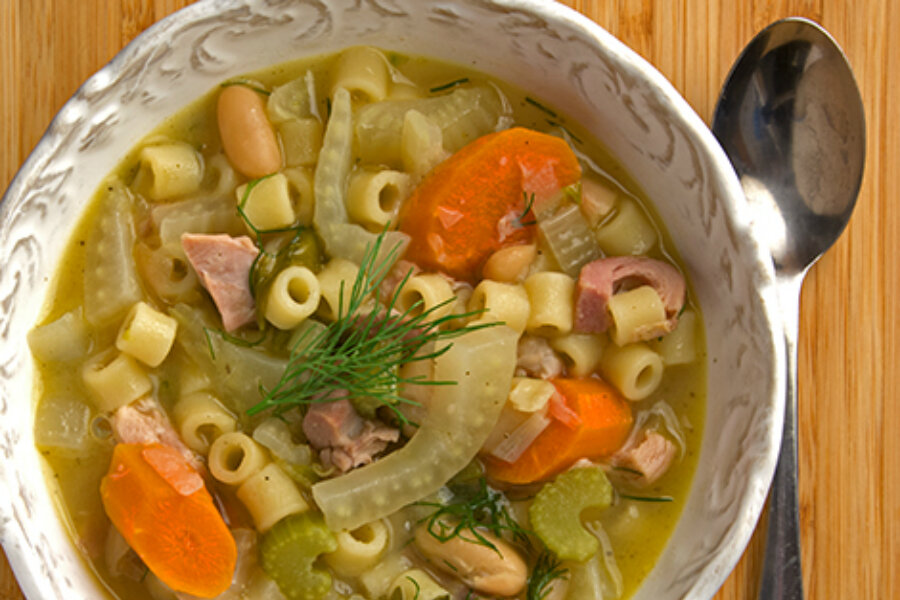Chicken fennel soup
Loading...
I’ve been not cooking lately. Yes, we’ve been crazy busy at times, with long hours away from home and non-meshing schedules. But it’s been more than that or simple midwinter malaise. I just didn’t seem to be in the mood to get in the kitchen, even when all the ingredients for a particular dish were in the house. I needed a kick in the pants to get over myself. It came in the form of a PBS show.
No, it wasn’t a cooking show. No Jacques Pepin. No Lidia. It was the Ken Burns documentary “Lewis & Clark: The Journey of the Corps of Discovery.” Growing up in St. Louis, I was profoundly shaped by living on the banks of the Mississippi. All St. Louisans are, whether we know it or not. And I was steeped in the history of the Louisiana Purchase — and the Lewis and Clark Expedition, which had begun just upriver from St. Louis, where the Missouri River flows into the Mississippi.
Years ago, I read some of the journal Meriwether Lewis and William Clark kept on their journey. The occasional entry spoke matter-of-factly about a bear attack or being kicked by a horse, but countless entries ended with “skeeters were turrible fierce.” Suffice it to say, I knew I wasn’t expedition material.
The documentary made me even more certain of that fact. At one point, well up the Missouri and approaching the Continental Divide, the river became so shallow and rocky that they had to portage their canoes and provisions around this stretch. Of course, before they could do this, they had to fashion primitive carts from young sycamore trees. One shallow section became seven, and the portage took a month to complete.
The shores were so rough and treacherous during the portage that a pair of moccasins would last no more than two days. The first night, the men would repair their moccasins. The next night, they would make new pairs. This after portaging all day, making a camp, cooking and eating dinner. Dinner was another matter. When hunting went badly, they had to make do. As the journal put it, bear oil and roots became “an agreeable dish.”
There was no “being in the mood” to make your own shoes every other day, or to eat whatever you could scrape together and be glad for it. It was time for me to get back in the kitchen, with its gas stove and electric lights and refrigeration, and cook something I hadn’t had to grow, dig up or kill.
This soup has nothing to do with Lewis and Clark’s exploits. Turns out it’s actually a traditional Italian soup — the fennel bulb, cannellini beans, lemon juice, and pasta are your first clues. But I didn’t start with a recipe. Chicago’s sudden single-digit temperatures put me in the mood for some soup. Marion had roasted two pans of chicken drumsticks a couple of nights before and there were plenty of leftovers, so I started there. I thought of the fennel bulb next and added ingredients in my head until I got pretty much where the recipe ended up.
Many soup recipes call for adding prepped vegetables to the broth raw. Sometimes I do that. But for this soup, I sweated them in butter and olive oil first. I think it adds depth to their flavors. As did the roast chicken. You can certainly use uncooked chicken, but the cooked chicken brings something extra to the party. However you cook it, you’ll end up with something better than bear oil and roots.
Chicken Fennel Soup
Serves 4 to 6
2 tablespoons olive oil
2 tablespoons unsalted butter
1 medium onion, chopped
1 fennel bulb, cored and thinly sliced, fronds reserved
2 medium carrots, sliced on the diagonal
2 medium ribs celery, including leaves, sliced
salt and freshly ground black pepper
2 cloves garlic, minced
6 cups homemade or store-bought chicken broth (plus extra, if needed)
1 15-ounce can cannellini beans, drained and rinsed
2 cups cooked chicken, cut/torn into small bite-sized pieces (see Kitchen Notes)
1 bay leaf
3/4 cup uncooked ditalini (see Kitchen Notes)
zest of 1 lemon, plus 2 tablespoons lemon juice
1. In a large, heavy Dutch oven or soup pot, heat oil and butter over medium flame, swirling to combine. Add onions and cook, stirring occasionally, for about 2 minutes. Add fennel, carrots and celery to pot. Season lightly with salt and pepper, and stir to coat with oil and butter. Cook, stirring occasionally, for about 5 minutes. Be careful not to burn — you want to sweat the vegetables, not brown them. Reduce heat, if necessary. Clear a spot in the middle of the pot and add garlic. Cook, stirring, until fragrant, about 45 seconds.
2. Add broth to pot, along with cannellini beans, chicken and bay leaf. Bring to a boil over medium-high heat, then reduce to a simmer. Cook uncovered for about 10 minutes. Stir in ditalini and cook until ditalini is just al dente, 10 to 11 minutes. Remove from heat.
3. Meanwhile, chop 2 tablespoons of fennel fronds. Stir fronds, lemon zest and lemon juice into soup. Taste and adjust seasonings with salt. Serve with a crusty bread.
Kitchen Notes
Cooked chicken or not? As I said above, the roasted chicken adds to the umami for me. If you don’t have any on hand, use boneless skinless chicken thighs — they’ll add more flavor than chicken breasts.
Pick your pasta. I love ditalini for soups, especially if I’m adding beans, Its size and shape matches the beans, and it’s spoon-friendly. Egg noodles are another popular choice for this kind of soup.
Related post on Blue Kitchen: Creamy carrot soup








